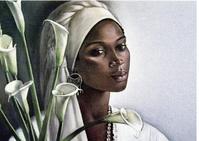Michael Robinson, Gleaner Writer 
A painting by Samere Tansley. - Contributed
Edna Manley's Bead Seller, a stylised sculpture depicting a kneeling vendor holding her wares, ushered in the dawn of Jamaica's contemporary art movement. Since the creation of the piece in 1922, there has been a parade of artists who have contributed to the form and substance of the island's artistic heritage. Jamaican art, however, can be traced as far back as the first-known Jamaicans, the Tainos.
Their petroglyphs hewn into cave walls and pictographs, or cave paintings, are evidence of Jamaica's art history, possibly going as far back as the 11th century AD.
Time has seen us make and break records in the fields of music and sports. This little island in the Caribbean basin has had a disproportionately transformative effect on the world. However, 1,000 years after the eradication of the Taino population, Jamaica has yet to make a lasting impact on the global art scene.
Jamaican artists have made great strides since the artist formerly known as Edna Swithenbank started the Cultural Training Centre, which later became the Edna Manley College. Formally trained artists like Barrington Watson and George Rodney have exhibited all over the world, as have intuitive creators such as Ras Dizzy and Everald Brown.
Along the north and east coasts, three million tourists represent a potential market of about $1.5 billion in spending power. They spend largely on accommodations and souvenirs.
Many of them buy the art in the craft markets or on the sidewalk. The avid collectors among them buy originals and high-end giclee prints, available at some hotels and area galleries.
But something is still missing.
Our neighbour, Cuba, has managed to establish a real presence in the global marketplace. By producing art in great volumes of a consistently high quality, Cuba has become known worldwide as the place to find good art at affordable prices.
People go to Cuba to buy art and resell it in the wider Caribbean, North America and Europe. There are various levels in terms of price and quality of work, but one thing is undeniable: Cuban art is in demand.
Like Jamaica, the first known expressions of Cuban creativity are cave paintings. Like us, the work displays African, European and North American influences. However, unlike us, the Cubans have managed to create an art industry.
Free education means that a greater number of Cubans may study art right up to the degree level. A higher literacy rate may also bolster the quality of their output. But the real key to the establishment of Cuba as an art mecca may lie in marketing. It is true that there has been no cohesive push to market Cuban art on the world stage. The immense popularity of the Cuban brand may lie in the tried-and-true marketing strategy: create a good product, make it hot, and then make it hard to get.
Talented artists
The product is good. Cuba's sidewalks and craft markets are chock- full of talented artists - trained, untrained and partially trained - who are willing to part with quality pieces for what visitors consider a more-than-reasonable sum.
The visitors leave with the work and either hang it at home, where their circle of friends and acquaintances are all exposed to the work. Word of mouth has been the most valuable marketing tool since humans started to communicate.
Thanks to the US-enforced embargo that has been in effect since 1962, the hard-to-get part has been taken care of. The rest has been a matter of course. Cuba is world-famous for its art almost as much as it is for its fragrant cigars, and the world is beating a path to its door.
Jamaican art has already proven its mettle on the international scene. Our art is in the home of serious collectors all over the globe. Former US president, Bill Clinton, has work by ceramicist Gene Pearson.
Our sidewalk artists and craftsmen are able to eke out a living from sheer sales volume. We have the product. What is needed now is a cohesive promotional element to establish Jamaica as a household name in the minds of those seeking creative visual output.
Promotion
In the absence of external constraints like a US embargo, local artists have turned to innovative methods of promotion. Onieka Russell's blog, Art Jamaica ,(www.artjamaica.blogspot.com) showcases Jamaican artists as well as artists showing in Jamaica. A reference source for artists, the site also features articles as well as information about upcoming shows and submission information. Many young artists are also exhibiting outside traditional gallery spaces in an effort to reach a wider audience. But more needs to be done.
Art festivals like the world's largest, Glasgow's Festival of Contemporary Visual Arts, create avenues for exposure which translates into sales for participating artists.
The Caribbean Artisan Network will be hosting the Caribbean Arts and Crafts Festival this March in the British Virgin Islands. Theirs is an event that showcases the work of artists and artisans, while creating valuable network connections between the producers and wholesalers as well as retail buyers.
After only five years, the festival has become the region's biggest event of its kind. Such an event held here would not only be a boon to local creators, but would go a long way towards establishing Jamaica as a viable brand in the world of arts and crafts.
In order to be sustainable, Jamaican art has to become an industry. We need a unified approach if we are to be an attractive option to the rest of the world.
Artists and artisans may view their output differently, they may have differing ideas about how to market their work, but the goal is always sales.
The solutions may be many, but the objective is singular. On this common ground lies the answer to the future of Jamaican art.

